Subordinate Everything Else to the Above Decision
Subordinate to Component Constraint
Tea Shop Component Constraint Example
Operational knowledge required
Deciding how to Subordinate to the Constraint requires operational knowledge of your system. This note is here to point out the boundary between strategy and operations that we find ourselves on. Strategy gets you to the point of Subordinating a particular input or output to the Constraint. How you will Subordinate it depends on what actions you can take in your specific operational context.
We start with the following scenario after identifying the Component Constraint. As a reminder, the Constraint is the time it takes for our Kettle to boil the Water.

We restate how we Decided to Exploit the above Constraint. We mentioned:
- 100% of the time Kettle is in use
- pre-boiled or otherwise potable water available for warming by Kettle
- hot water available when Tea Shop opens
Subordinate steps
Perform Subordinate Step 1 - For the Constraint or one of its inputs or outputs, add a single input or an output.
We take note that we can prepare more Hot Water if we start with Potable Water and don't have to boil it. We refine Water into Potable Water to highlight this requirement.
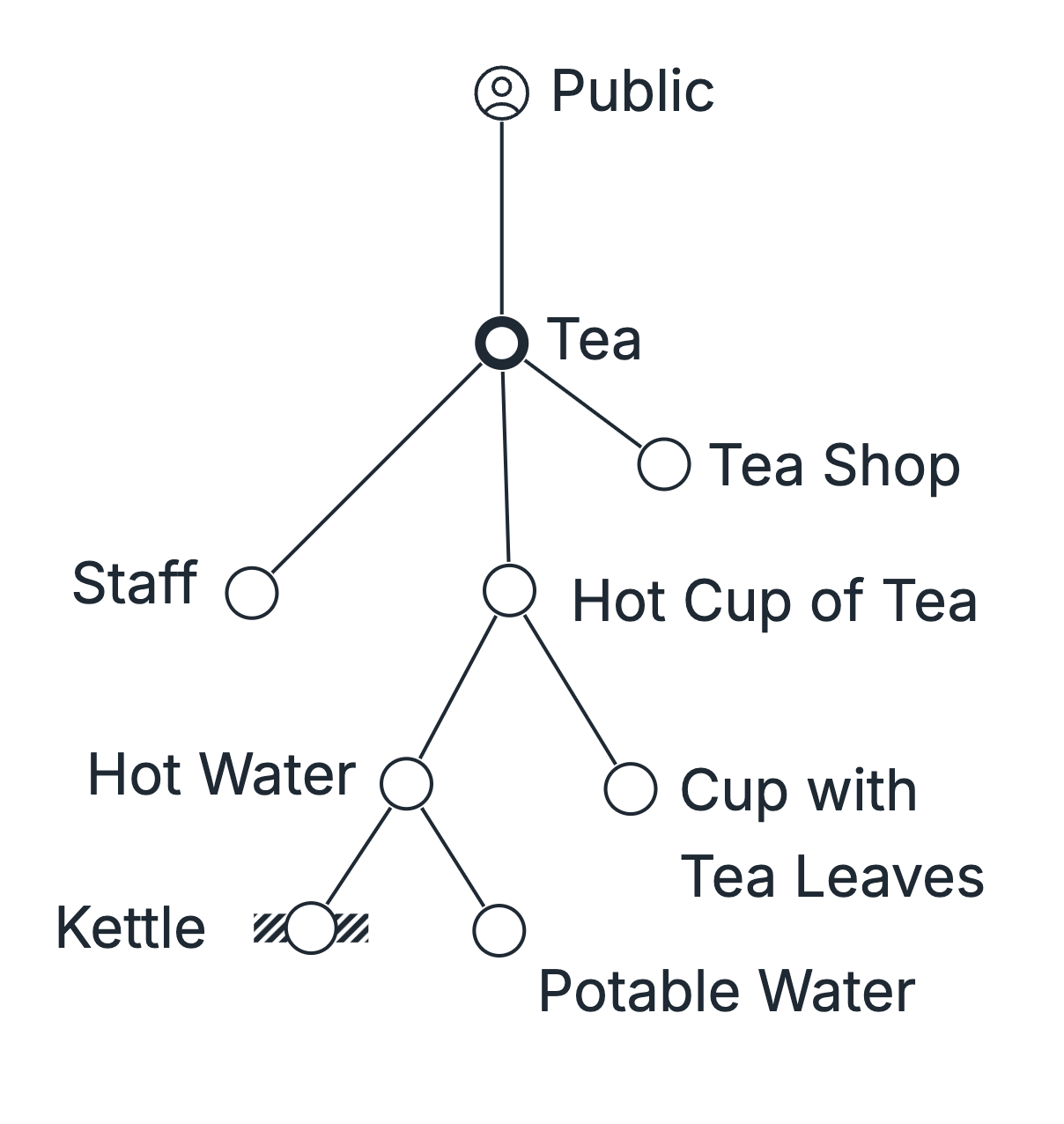
Perform Subordinate Step 2 - Select actions to take to Subordinate the input or output to the Constraint.
What actions are we to take at the Potable Water that will help ensure 100% of the time Kettle is in use?
- ensure that we have enough Potable Water available for warming by the Kettle whenever Kettle becomes available
What actions are we to take at the Potable Water that will help ensure pre-boiled or otherwise potable water available for warming by Kettle?
- verify and monitor potability of our utility water supply
- create a reservoir of potable water in case water supply is interrupted
- use Kettle when Tea Shop is closed to create Potable Water reservoir for next day
What actions are we to take at the Potable Water that will help ensure hot water available when Tea Shop opens?
- working backwards, if Hot Water is to be available right when Tea Shop opens, then Potable Water must be available for the Kettle before opening for as long as it takes to heat the water
We now ask, did we identify all relevant inputs and outputs and Subordinated them to the Constraint?
No, we are just getting started. We repeat the steps
Perform Subordinate Step 1 - For the Constraint or one of its inputs or outputs, add a single input or an output.
We recognize the importance of 100% Kettle utilization, so we distinguish a specific Kettle Minding role/practice to indicate someone responsible for utilizing the Kettle.
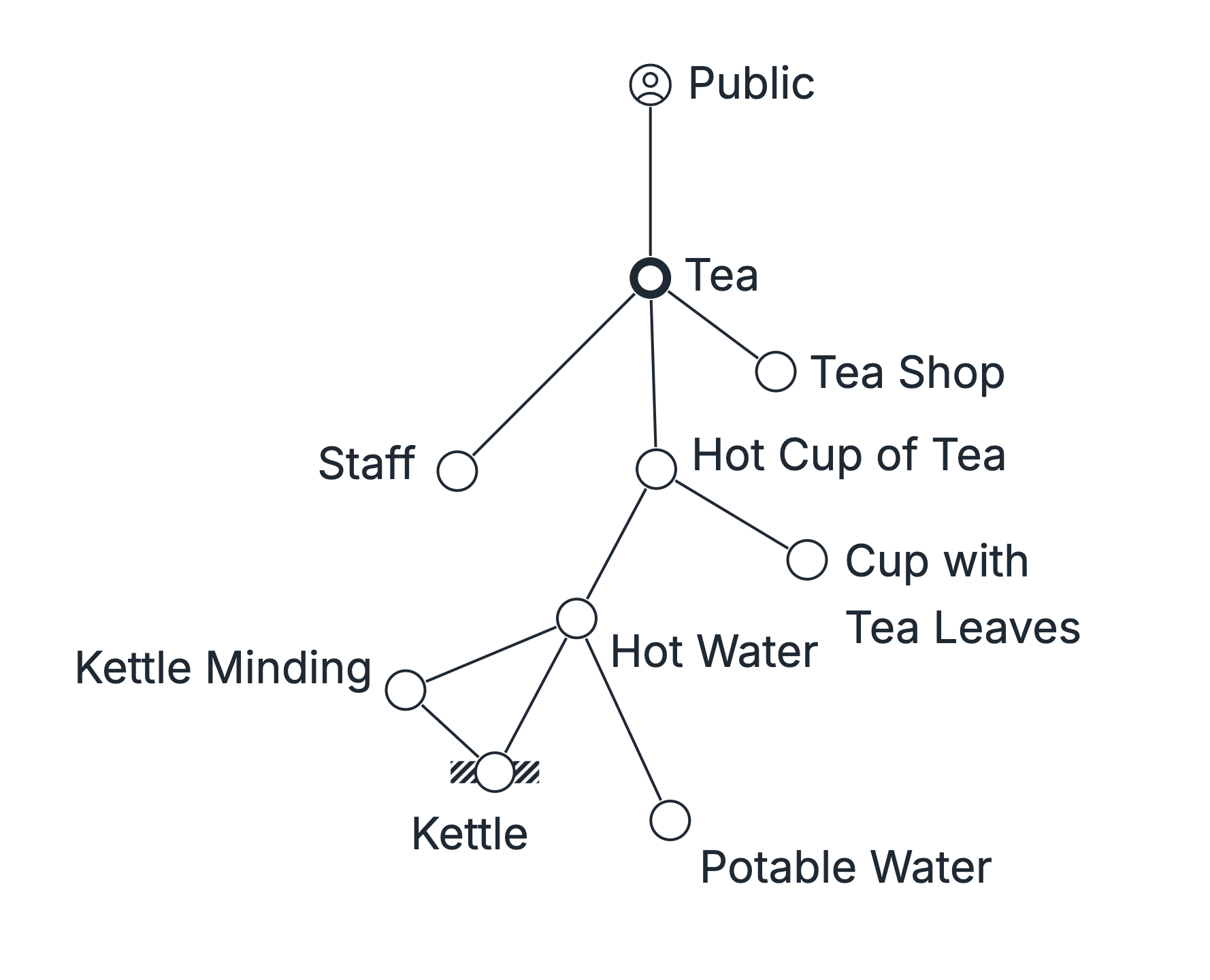
Note that even though we are adding a role/practice, this part of the Value Chain remains coherent and it can be read as Hot Water depends on Kettle Minding AND Kettle AND Potable Water, where Kettle Minding depends on Kettle.
Perform Subordinate Step 2 - Select actions to take to Subordinate the input or output to the Constraint.
What actions are we to take with Kettle Minding that will help ensure 100% of the time Kettle is in use?
- train the Kettle Minding staff so that they
- are always available to empty and refill the Kettle when a batch of water heating completes.
- immediately escalate any shortage of outputs like Cup with Tea Leaves
What actions are we to take with Kettle Minding that will help ensure pre-boiled or otherwise potable water available for warming by Kettle?
- train the Kettle Minding staff so that they immediately escalate any shortage of inputs like Potable Water
What actions are we to take with Kettle Minding that will help ensure hot water available when Tea Shop opens?
- train the Kettle Minding staff to start water heating sufficiently prior to Tea Shop opening
We ask again, did we identify all relevant inputs and outputs and Subordinated them to the Constraint?
We notice existing detail, so we repeat the steps.
Perform Subordinate Step 1 - For the Constraint or one of its inputs or outputs, add a single input or an output.
We already have the output detail of Cup with Tea Leaves included in our Value Chain. Let's consider what actions to take there.

Perform Subordinate Step 2 - Select actions to take to Subordinate the input or output to the Constraint.
What actions are we to take with Cup with Tea Leaves that will help ensure 100% of the time Kettle is in use?
- we need to ensure that there are always open Cups with Tea Leaves available to accept Hot Water from the Kettle
What actions are we to take with Cup with Tea Leaves that will help ensure pre-boiled or otherwise potable water available for warming by Kettle?
In this case, nothing comes to mind. Cups with Tea Leaves are on the output side of the Kettle so we are limited on what we could do here.
What actions are we to take with Kettle Minding that will help ensure hot water available when Tea Shop opens?
- we need to ensure that Cups with Tea Leaves are available prior to Tea Shop opening
We ask again, did we identify all relevant inputs and outputs and Subordinated them to the Constraint?
Let's continue and repeat the steps.
Perform Subordinate Step 1 - For the Constraint or one of its inputs or outputs, add a single input or an output.
For the Kettle to operate we need an energy source. For this example, the Kettle requires Electricity.
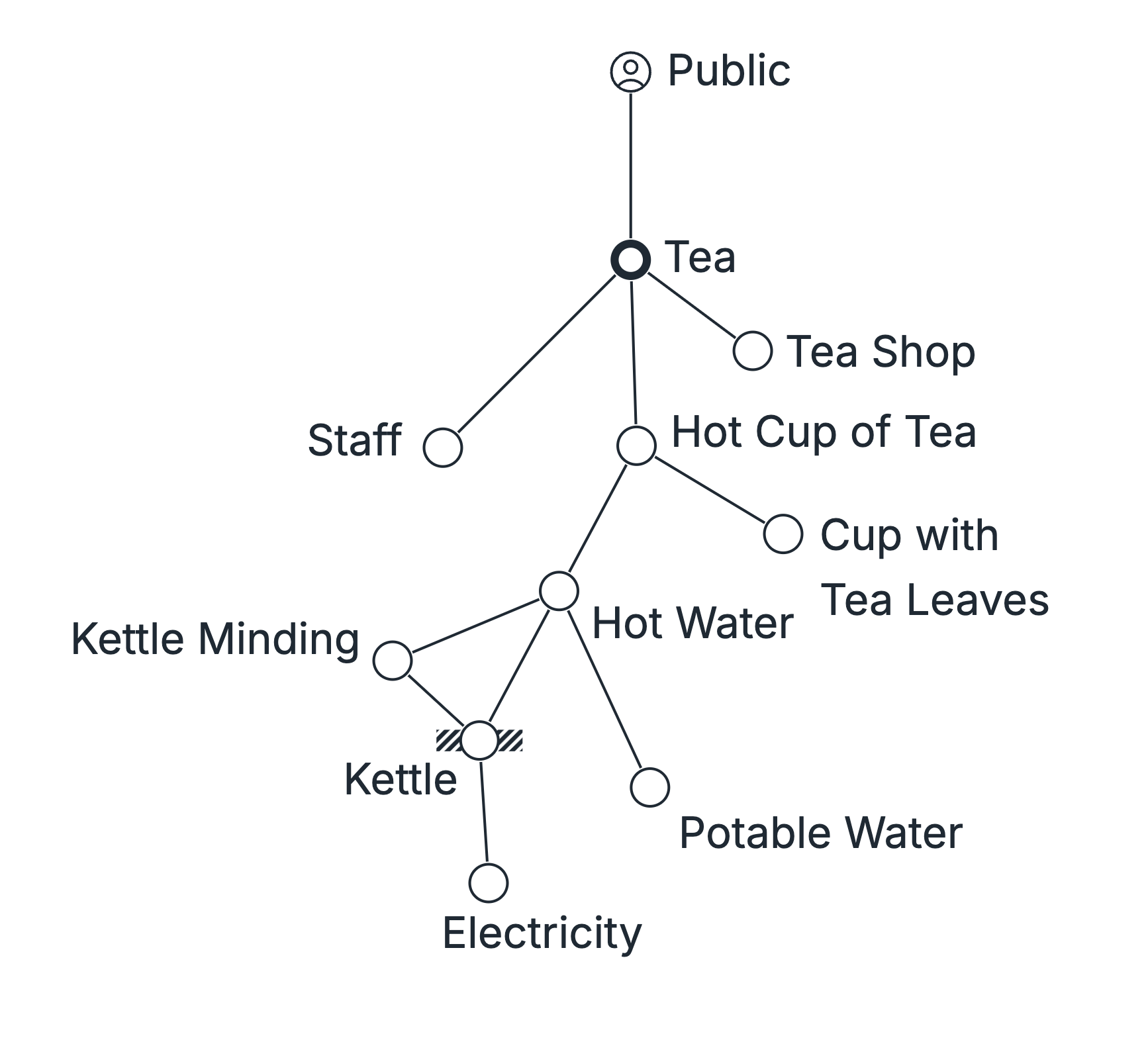
Perform Subordinate Step 2 - Select actions to take to Subordinate the input or output to the Constraint.
What actions are we to take with Electricity that will help ensure 100% of the time Kettle is in use?
- we may want to invest in a backup power source depending on the reliability of our Electricity supply
What actions are we to take with Electricity that will help ensure pre-boiled or otherwise potable water available for warming by Kettle?
In this case, no obvious actions come to mind as Potable Water is not dependent directly on Electricity.
What actions are we to take with Electricty that will help ensure hot water available when Tea Shop opens?
- ensure backup power source is replenished from Electricity overnight so it is available prior to Tea Shop opening
We ask again, did we identify all relevant inputs and outputs and Subordinated them to the Constraint?
One of our actions pointed out a need for an Electricity Backup, we add it now and repeat the steps.
Perform Subordinate Step 1 - For the Constraint or one of its inputs or outputs, add a single input or an output.
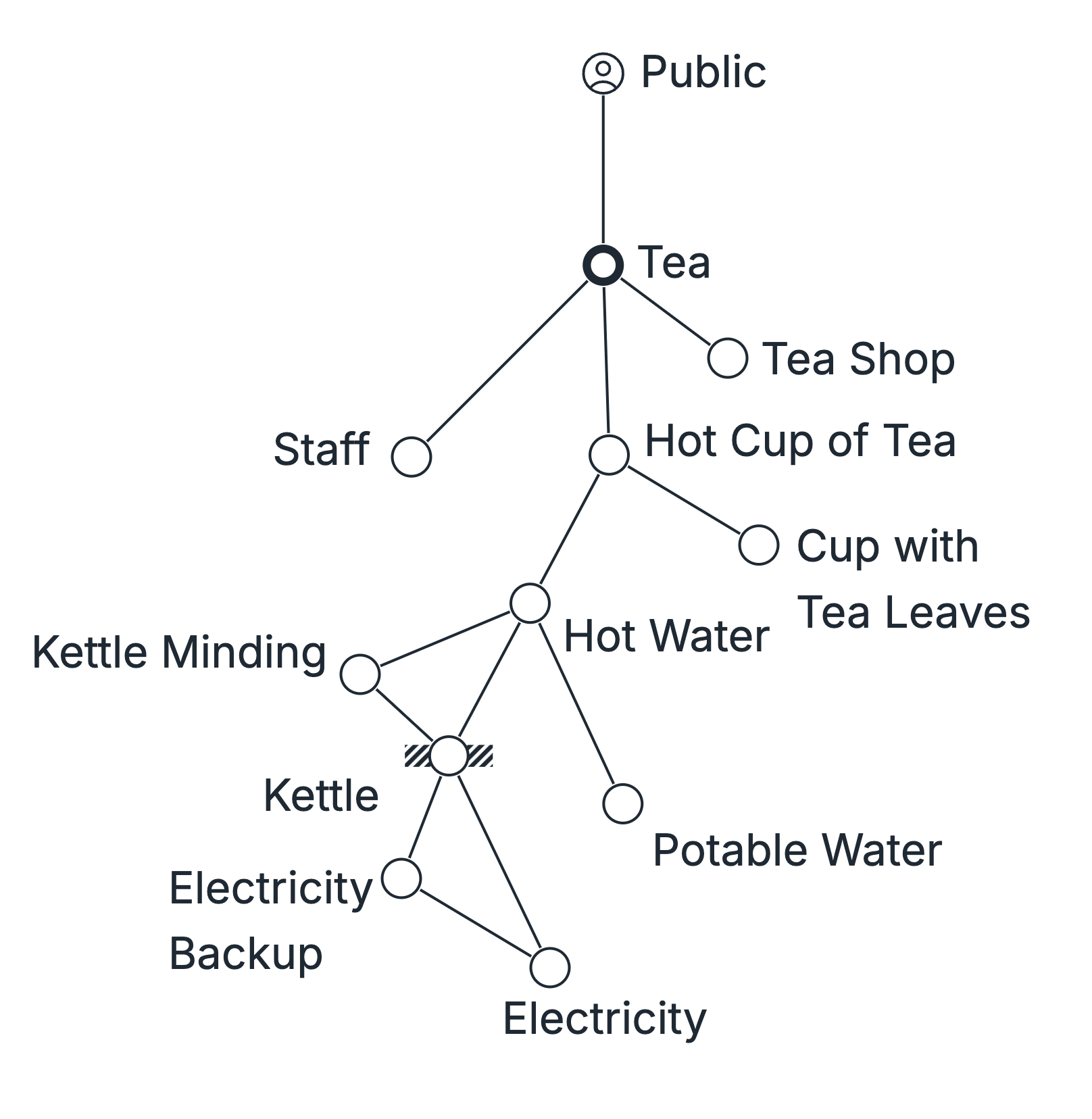
Perform Subordinate Step 2 - Select actions to take to Subordinate the input or output to the Constraint.
What actions are we to take with Electricity Backup that will help ensure 100% of the time Kettle is in use?
- always ensure that it is available when not in use
- periodically use Electricity Backup even when Electricity is available to verify it works as intended
What actions are we to take with Electricity Backup that will help ensure pre-boiled or otherwise potable water available for warming by Kettle?
In this case, no obvious actions come to mind as Potable Water is not dependent directly on Electricity Backup.
What actions are we to take with Electricty Backup that will help ensure hot water available when Tea Shop opens?
- ensure Electricity Backup is replenished from Electricity overnight so it is available prior to Tea Shop opening
We ask again, did we identify all relevant inputs and outputs and Subordinated them to the Constraint?
For the purpose of the excercise, let's stop here for now.
Summary and reflection
The Subordinate two-step procedure above prompted us to add detail to the Value Chain in order to Subordinate everything relevant to the Constraint. Once again, you are not modeling the entire Value Chain, but only the relevant portions for this particular step.
Furthermore, the two-step procedure generated (possibly a lot of) actions to take within the system. Since these actions are in service of Exploiting the Constraint, you should observe immediate improvement at the Constraint, and therefore in the entire flow of value of your system.
These actions could take time. Here is a list of everything generated in the example above:
- ensure that we have enough Potable Water available for warming by the Kettle whenever Kettle becomes available
- verify and monitor potability of our utility water supply
- create a reservoir of potable water in case water supply is interrupted
- use Kettle when Tea Shop is closed to create Potable Water reservoir for next day
- working backwards, if Hot Water is to be available right when Tea Shop opens, then Potable Water must be available for the Kettle before opening for as long as it takes to heat the water
- train the Kettle Minding staff so that they
- are always available to empty and refill the Kettle when a batch of water heating completes.
- immediately escalate any shortage of outputs like Cup with Tea Leaves
- train the Kettle Minding staff so that they immediately escalate any shortage of inputs like Potable Water
- train the Kettle Minding staff to start water heating sufficiently prior to Tea Shop opening
- we need to ensure that there are always open Cups with Tea Leaves available to accept Hot Water from the Kettle
- we need to ensure that Cups with Tea Leaves are available prior to Tea Shop opening
- we may want to invest in a backup power source depending on the reliability of our Electricity supply
- ensure backup power source is replenished from Electricity overnight so it is available prior to Tea Shop opening
You are now doing strategy!
Richard P. Rumelt wrote that good strategy has a kernel made of three parts1:
- diagnosis that explains the nature of the challenge
- guiding policy for dealing with the challenge
- coherent actions required to carry out the guiding policy
In this sense, you performed diagnosis when you Identified the System Constraint. You created the guiding policy when you Decided How to Exploit the System's Constraint. And now, you generated a set of coherent actions by Subordinating Everything Else to the Decision.
While there is still much more to strategy, you are on your way.
Rumelt, R.P. (2012), "Good Strategy/Bad Strategy: The Difference and Why It Matters", Strategic Direction, Vol. 28 No. 8. https://doi.org/10.1108/sd.2012.05628haa.002
Up next
After taking action in your system and observing the effects, you may need to revisit the Subordinate steps above.
Once you feel that you Subordinated everything to the Constraint, then it may be time to Elevate the System's Constraint, proceed there next.
If you are curious what Subordinating to the Constraint is like for User or User Need, visit the Subordinate to User Constraint or Subordinate to User Need Constraint lessons.
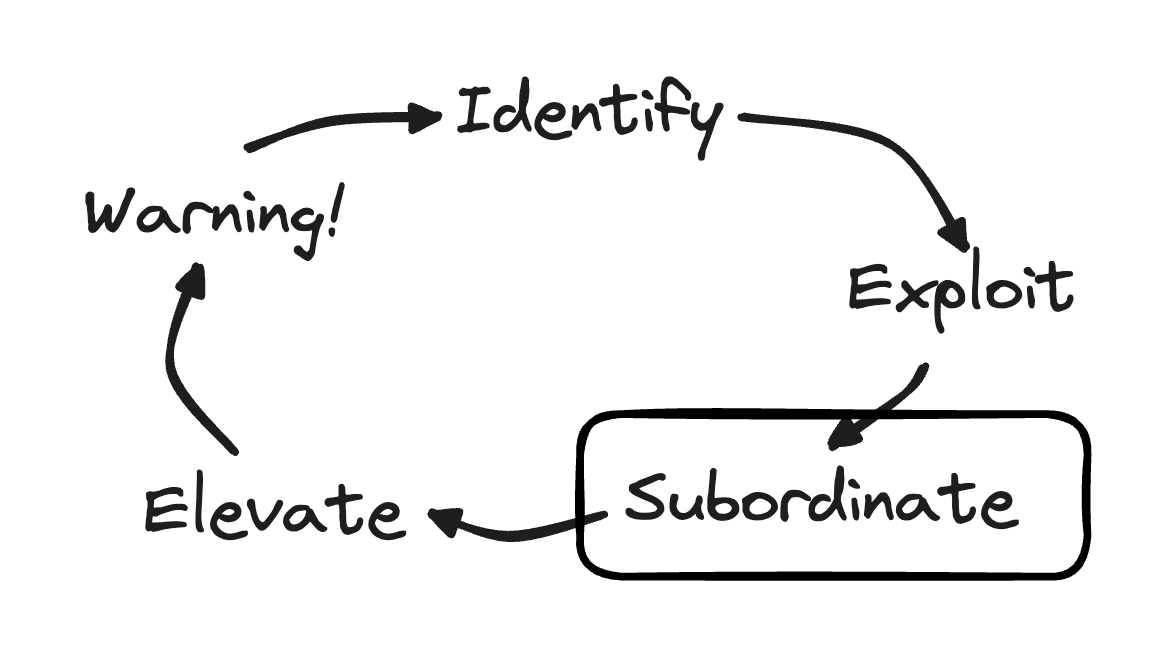
Go back
Subordinate Everything Else to the Above Decision
Learn to subordinate all non-constraints to the primary constraint in your value chain. This guide helps identify relevant non-constraints and ensure efficient flow of value through the system.
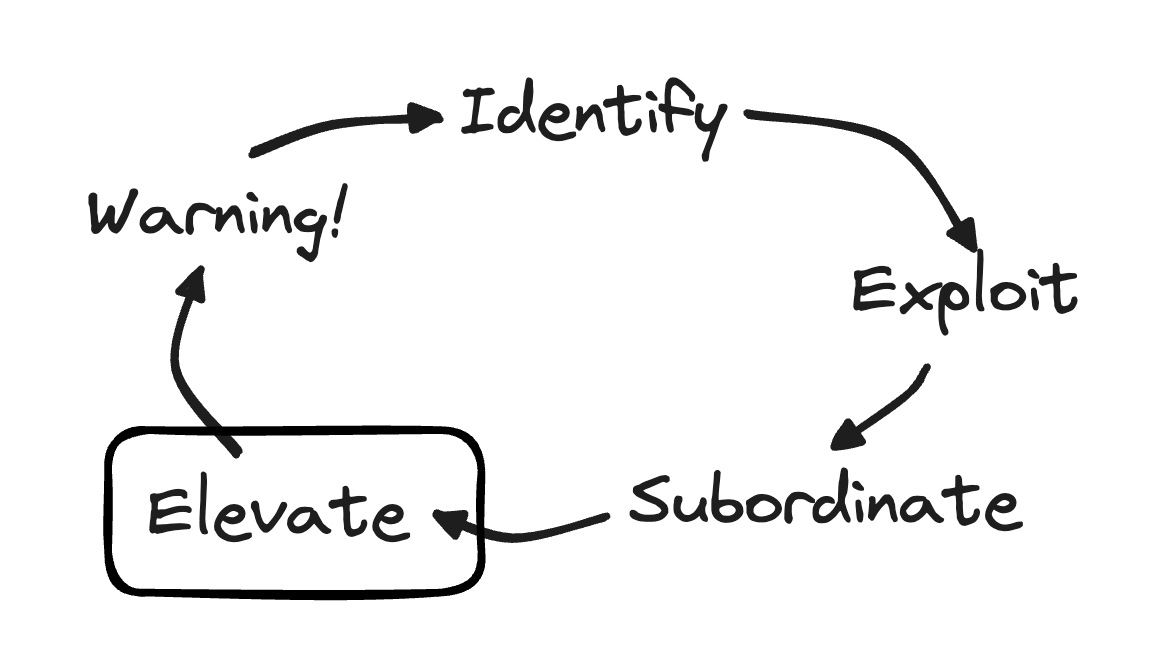
Up next
Elevate the System's Constraint
Explore the process of elevating the system's constraint by stepping out of the process flow and considering evolutionary stages. Learn how to identify, exploit, and elevate constraints within your system.
